As an avid RVer, you understand the importance of having a dependable power source to fuel your adventures on the road. Whether you’re camping in a national park, boondocking in a remote location, or embarking on a cross-country journey, having a reliable battery for RV is essential to ensure a smooth and enjoyable trip.
AGM (Absorbent Glass Mat) batteries have become a popular choice for RVers due to their outstanding performance, maintenance-free operation, and ability to withstand the demands of off-grid living.
In this guide, we’ll take an in-depth look at the best AGM RV batteries available, their key features, benefits, and factors to consider when choosing the right battery for your specific needs. Let’s dive into the world of AGM RV batteries and discover how they can enhance your RVing experience.
Contents
- Quick Recommendations
- The Basics About AGM RV Battery
- The Benefits of AGM RV Batteries
- 5 Best Deep Cycle AGM Batteries for RV
- Factors to Consider When Choosing AGM RV Batteries
- Proper Maintenance of AGM RV Batteries
- Tips for Extending the Lifespan of AGM RV Batteries
- FAQs About AGM Batteries for RV
- Conclusion
Quick Recommendations
| Best AGM Batteries For RV | Price | Our Ratings | |
| #1 | Renogy 12V AGM Battery – Best Overall | $$$ | ***** |
| #2 | Universal Power Group UB121000 – Editor’s Choice | $$$ | ***** |
| #3 | Weize 100Ah AGM Battery – Best Value | $$ | ***** |
The Basics About AGM RV Battery
Understanding the AGM Battery Technology
AGM stands for Absorbent Glass Mat, which refers to the unique design and technology used in these batteries. AGM batteries are a type of valve-regulated lead-acid (VRLA) battery that utilizes a glass mat separator to suspend the electrolyte, eliminating the need for free-flowing liquid electrolyte found in traditional lead-acid batteries. You can easily identify an AGM battery by a few simple observations such as label or appearance.
The key components of an AGM battery include:
Lead Plates: AGM batteries consist of lead plates, which are the positive and negative electrodes of the battery. These plates react with the sulfuric acid in the electrolyte to store and release electrical energy during charging and discharging cycles.
Glass Mat Separator: The glass mat separator is a critical component of AGM batteries. It is made of micro-fine glass fibers that absorb and hold the electrolyte, preventing it from leaking or spilling even if the battery is damaged or turned upside down. The glass mat separator also allows for efficient ion exchange during charging and discharging.
Electrolyte: The electrolyte in an AGM battery is a mixture of water and sulfuric acid, which facilitates the flow of ions between the positive and negative plates during the electrochemical reactions.
Pressure-Relief Valve: AGM batteries are designed to be sealed and maintenance-free. To regulate internal pressure and prevent excessive buildup of gas, AGM batteries are equipped with a pressure-relief valve that opens when the pressure reaches a certain level.
Charging Process of AGM Batteries
The charging process of AGM batteries involves converting electrical energy from an external power source into chemical energy stored in the battery. Let’s walk through the steps of the charging process:
Absorption Charge
During the initial stage of charging, the AGM battery is in the absorption phase. The battery charger supplies a constant current to the battery, causing the positive lead plate to release electrons and the negative plate to accept electrons. This creates a flow of electrical current through the battery.
Oxygen Recombination
As the battery charges, oxygen is generated at the positive lead plate, and hydrogen is generated at the negative lead plate. The glass mat separator plays a crucial role in the process, as it allows the oxygen and hydrogen to recombine and form water, preventing the gases from escaping the battery.
Float Charge
Once the battery reaches its full charge capacity, the charging process transitions to the float charge stage. During this stage, the battery charger reduces the charging current to a lower level to maintain the battery’s charge without overcharging it.
Equalization Charge (Optional)
Some AGM batteries may require an equalization charge occasionally. This high-voltage charge is applied to the battery to balance the cell voltages and remove any sulfation that may have occurred during prolonged discharging.
Discharging Process of AGM Batteries
The discharging process of AGM batteries involves converting the stored chemical energy back into electrical energy to power connected devices or systems. Here’s how the discharging process unfolds:
Ion Migration
When a load is connected to the AGM battery, the electrical circuit is completed, and the battery begins to discharge. The glass mat separator allows for efficient ion migration between the positive and negative lead plates, facilitating the electrochemical reactions.
Sulfuric Acid Reaction
As the battery discharges, the sulfuric acid in the electrolyte reacts with the lead plates, forming lead sulfate and releasing electrical energy in the form of electrons. The electrons flow through the connected circuit, powering devices and appliances.
Reversible Reaction
One of the key features of AGM batteries is their ability to undergo reversible reactions during charging and discharging. When the battery discharges, lead sulfate forms on the plates, but this reaction can be reversed during the charging process, converting the lead sulfate back into lead and lead oxide.
Voltage Drop
As the battery discharges, its voltage gradually drops, indicating the reduction in the available electrical energy. AGM batteries are designed to maintain a relatively stable voltage throughout most of the discharge cycle, providing consistent power until reaching their recommended state of charge.
The Benefits of AGM RV Batteries
A reliable power source is vital to ensure you can comfortably run your appliances, lights, and electronics while on the road. Among all the options, AGM RV batteries have risen to prominence in the RVing community, thanks to their numerous advantages:
Deep Cycle Capability: AGM batteries are designed to handle deep cycling, making them perfect for RV applications. They can be discharged to a low state of charge and then recharged repeatedly without compromising their performance.
Maintenance-Free Operation: Unlike traditional lead-acid batteries, AGM batteries are sealed, eliminating the need for adding water regularly. This feature reduces maintenance efforts, making them hassle-free for RVers who want more time to enjoy their travels.
Vibration and Shock Resistance: RVs encounter rough terrains and vibrations during travel. AGM batteries are designed with sturdy construction and absorbent glass mat separators, offering excellent resistance to vibrations and shocks.
Spill-Proof Design: AGM batteries have a spill-proof design, making them safe to use in any orientation. You can mount them in any position without worrying about acid leaks or spills.
Fast Charging and High Discharge Rates: AGM batteries can be charged at a faster rate compared to traditional lead-acid batteries. They also offer high discharge rates, providing ample power for all your RV appliances and electronics.
Improved Performance in Extreme Temperatures: AGM batteries perform exceptionally well in both high and low-temperature conditions, making them suitable for RVers who explore diverse climates.
Longer Service Life: With proper maintenance, AGM batteries can have a longer service life compared to traditional lead-acid batteries, making them a cost-effective investment for RVers.
5 Best Deep Cycle AGM Batteries for RV
1. Best Overall: Renogy Deep Cycle AGM Battery
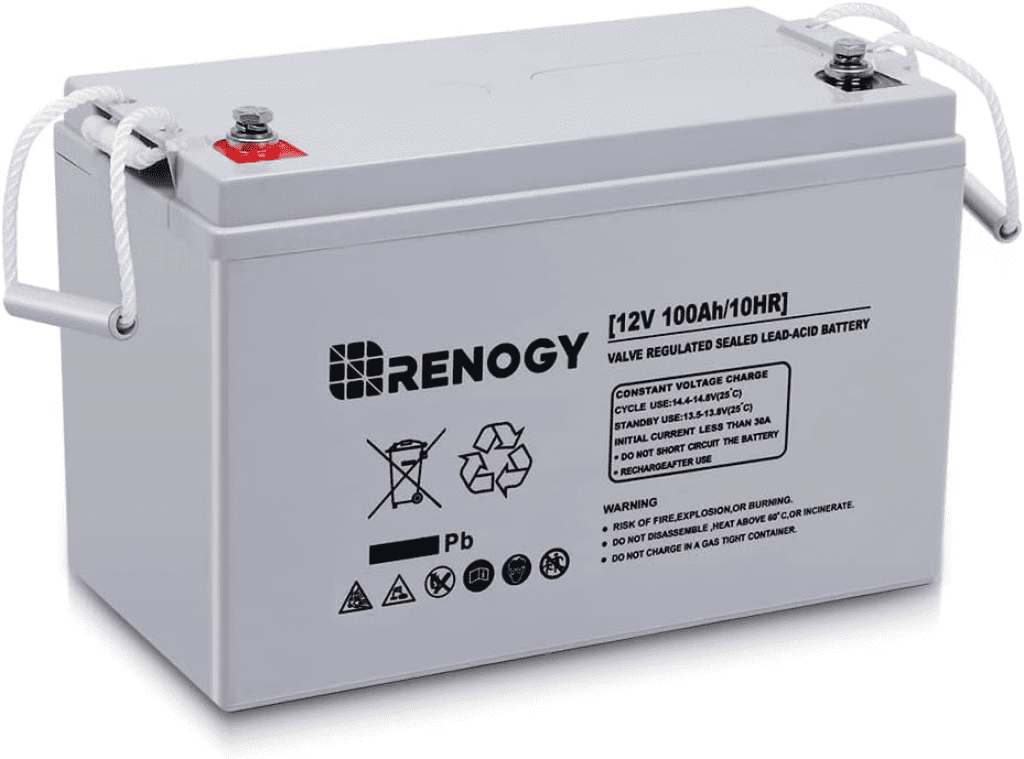
At a glance:
| Brand | Renogy |
| Model | RNG-BATT-AGM12-100 |
| Voltage | 12V |
| Capacity | 100 Ah |
| Operating Temperature | Discharge: 5°F-122°F; Charge: 5°F-104°F |
| Storage Temperature Range | 5°F-104°F |
| Max Charge Current | 30A |
| Dimension | 13.1 x 6.9 x 8.6 inch |
| Weight | 63.9 pounds |
| Warranty | 2 Years |
Why we love it:
The Renogy Deep Cycle AGM Battery is a top-notch performer in the realm of solar energy storage applications. With its advanced features and cutting-edge technology, this battery offers exceptional performance, reliability, and convenience.
One of the most impressive features of this battery is its robust construction. Manufactured with thick absorbent glass mat (AGM) separators and advanced valve-regulated technology, the Renogy AGM Battery ensures that you are free from acid leakage worries and the need for frequent maintenance. The AGM design keeps the electrolyte securely absorbed within the fiberglass mat, making the battery spill-proof and perfect for any orientation in your solar setup.
Notably, the improved electrolyte formula is designed to provide stable battery capacity and exceptional discharge performance, even in extreme temperature conditions. Whether you’re facing freezing temperatures at 5℉ (-15℃) or sweltering heat at 122℉ (50℃), the Renogy AGM Battery continues to perform optimally, ensuring uninterrupted power supply in all weather conditions.
The proprietary quinary alloy plates and exclusively treated plate grids contribute to the battery’s impressive performance. By enabling low internal resistance and supporting high discharge currents of up to 10 times the battery-rated capacity, this battery has the capability to power high-current home appliances without breaking a sweat. This means you can rely on the Renogy AGM Battery to support heavy loads and appliances with ease, making it ideal for off-grid and backup power applications.
Another significant advantage of the Renogy AGM Battery lies in its self-discharge rate. When not in use, this battery boasts an impressively low monthly self-discharge rate of as low as 3%. This is 5 times lower than their flooded battery counterparts, ensuring that your stored energy remains intact and available when you need it the most.
When it comes to installation, Renogy provides flexibility. You have the option to connect multiple batteries either in series or in parallel to achieve your desired power capacity. To get the best results, it’s recommended to connect batteries with the same AGM type, capacity (Ah), and voltage (V). This allows you to customize your energy storage setup according to your specific needs.
Pros
- High capacity
- Superior craftsmanship
- Outstanding discharge performance in extreme temperatures
- Flexible installation options
Cons
- Heavy
- Expensive when compared with other options
2. Editor’s Choice: Universal Power Group UB121000 Solar Wind AGM Battery
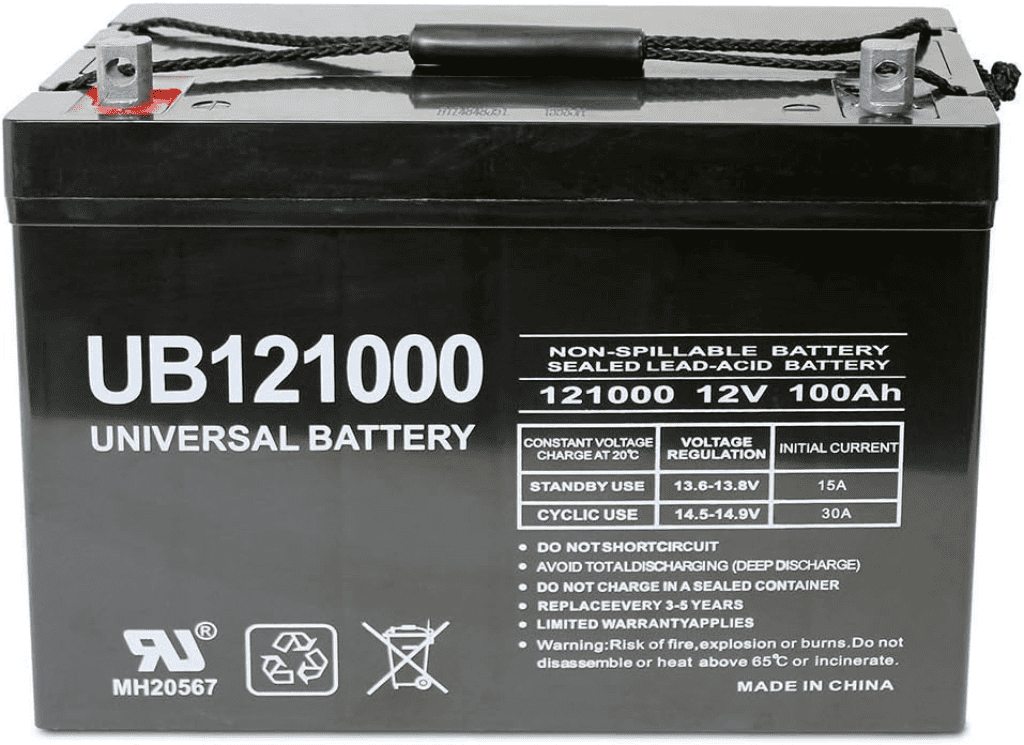
At a glance:
| Brand | Universal Power Group |
| Model | UB121000 |
| Voltage | 12V |
| Capacity | 100 Ah |
| Low Self-Discharge | 1-3% per month |
| Dimension | 12.17 x 6.61 x 9.16 inches |
| Weight | 60 pounds |
| Warranty | 1 Year |
Why we love it:
The Universal Power Group Solar Wind AGM Battery is a standout performer in the world of AGM batteries, offering a host of features that make it a top choice for various applications. Designed with convenience and efficiency in mind, this battery provides reliable power in tight spaces and is ideal for modern-day recreational vehicles.
Thanks to its sealed design, UB121000 can be the best AGM RV battery for those RVers with limited space for a battery bank, as it can be positioned in various ways without any worries about acid leakage or maintenance issues. Its lightweight and compact structure further add to the convenience of installation, making it effortless to integrate into most setups.
With a capacity of 12 volts and 100 Ah, the Universal Power Group UB121000 is well-equipped to meet the power demands of contemporary RVs with their array of convenient appliances. Additionally, for users with above-average power consumption, this AGM battery can be wired in series to provide 24, 36, or 48 volts of power, making it versatile for a wide range of applications. Whether you want to go off-grid on your RV or power multiple devices simultaneously, the UB121000 has you covered.
One of the most significant advantages of this AGM battery is its low internal resistance, allowing for faster recharging times compared to its competitors. Its high discharge rate also contributes to better temperature stability and tolerance, ensuring consistent performance even in challenging environments. Furthermore, the battery can easily recover from deep discharge cycles, making it a reliable and durable power solution.
Universal Power Group has engineered this battery to be vibration and shock-resistant, which means it can withstand rough handling and challenging conditions with ease. This robust construction ensures the battery can handle everything thrown at it, making it suitable for various outdoor and mobile applications.
After reviewing multiple AGM battery options, it’s evident that the Universal Power Group UB121000 offers an excellent balance between price and performance. With its competitive pricing, it delivers exceptional value for its worth, making it a cost-effective choice for both novices and experienced users.
Pros
- Vibration and shock-resistant construction
- Fast recharging
Cons
- Not considered well-suited for solar applications
- Some reports of shorted cells
3. Weize 12 Volt 100Ah AGM Deep Cycle Battery
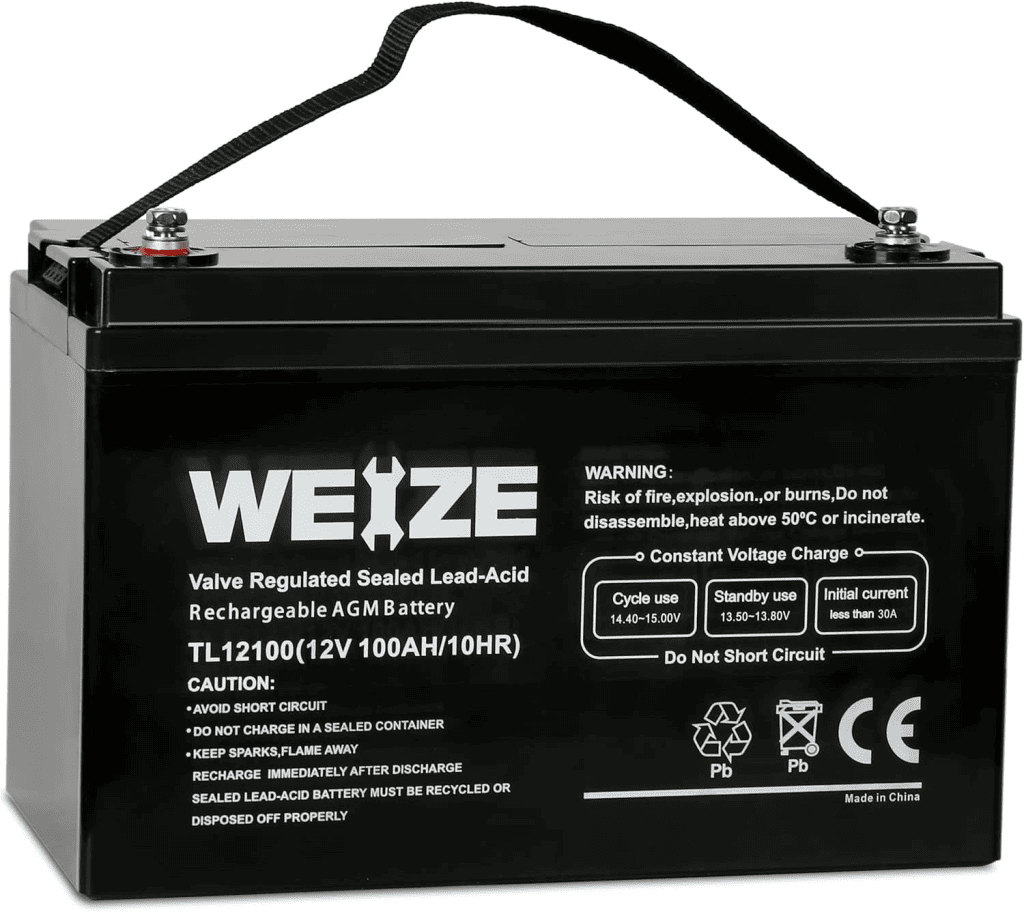
At a glance:
| Brand | Weize |
| Model | 12V100AH |
| Voltage | 12V |
| Capacity | 100 Ah |
| Self-Discharge Rate | 1-3% per month |
| Dimensions | 12.99 x 6.73 x 8.19 inches |
| Weight | 63 lbs |
| Certifications | UL & CE |
| Warranty | 2 Years |
Why we love it:
The Weize 12V100-1 Rechargeable AGM Battery stands out as an exceptional performer, offering state-of-the-art features and reliable performance in various camping environments. This battery is the go-to choice for full-time campers who traverse diverse weather conditions, thanks to its heavy-duty calcium-alloy construction.
The Weize 12V100AH features lower self-discharge rate with only 1-3% per month, allowing for extended storage periods before requiring recharging. However, it is recommended to keep the battery in a charged state and operate it within an appropriate temperature range to prolong the battery’s lifespan and enjoy consistent performance throughout their camping adventures.
The battery comes equipped with two Zinc-plated M8 terminal bolts for cable wiring, ensuring secure and reliable connections. Additionally, the container is marked with positive (+) and negative (-) icons for easy wiring identification, making the installation process hassle-free.
Built with rugged ABS container material, the Weize 12V100AH is designed to prevent air and spark ingress, rendering it both vibration-resistant and durable. For avid RV enthusiasts who frequently travel on rough terrains and prioritize safety, this AGM battery is a top choice. Its spill-proof design eliminates concerns about acid leakage, making it a reliable and secure power solution for all camping adventures.
The unique vent valve design further enhances the battery’s performance by controlling water loss, ensuring efficient operation over extended periods. Additionally, the battery has been recognized by UL and CE certifications, guaranteeing its compliance with stringent quality and safety standards.
One of the most appealing aspects of the Weize 12V100AH AGM battery is its ability to be wired in series, providing users with more powerful battery banks that can supply 24, 36, or 48 volts of power. This versatility makes it an excellent choice for large luxury motorhomes equipped with numerous residential-grade, power-hungry appliances. Whether it’s powering energy-demanding devices or supporting a comprehensive RV setup, this AGM battery proves to be the best option in its price range.
Pros
- Wide operating temperature range
- Low self-discharge rate of 1-3% per month
- Rugged construction
Cons
- Need improvements in quality control
4. Mighty Max Battery ML35-12 AGM Solar Battery
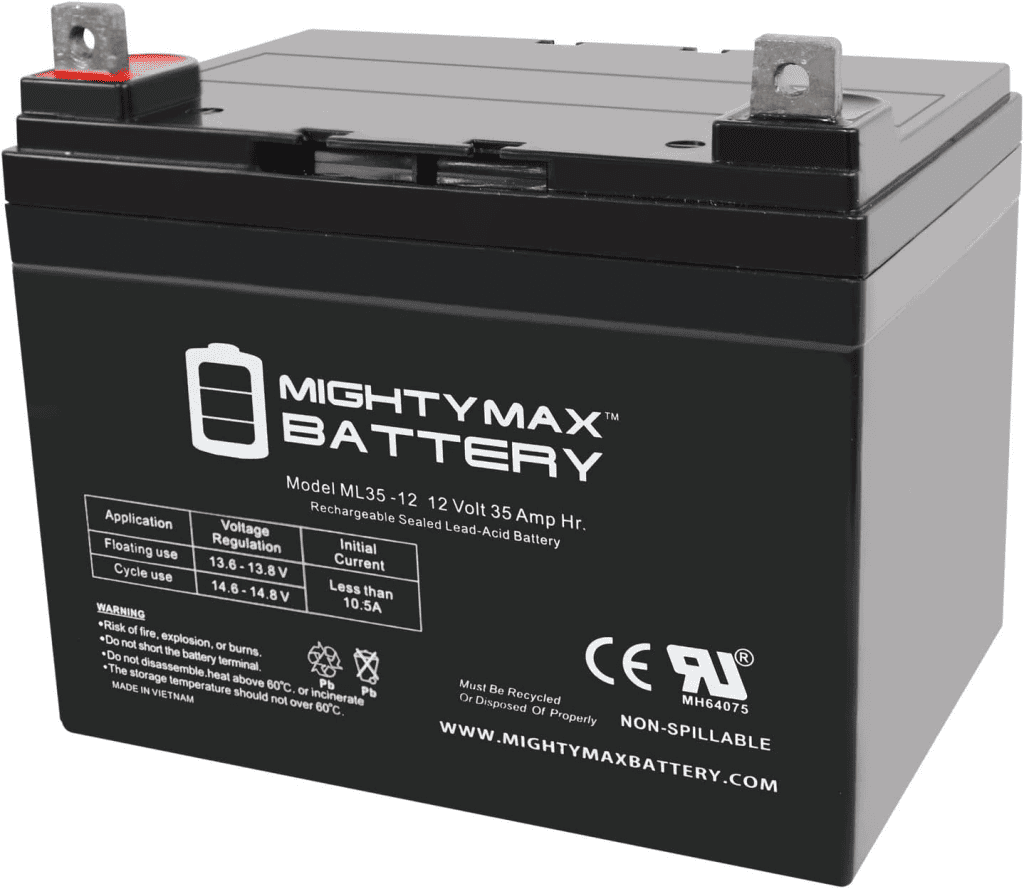
At a glance:
| Brand | Mighty Max |
| Model | ML35 12 |
| Voltage | 12V |
| Capacity | 35AH |
| Dimensions | 7.76 x 5.12 x 7.01 inches |
| Weight | 22.7 pounds |
| Certification | UL Certified |
| Warranty | 1 Year |
Why we love it:
Mighty Max Battery ML35-12 is undeniably one of the best AGM batteries for RV enthusiasts seeking a reliable small power backup on their adventures.
The heart of the Mighty Max ML35-12 lies in its state-of-the-art, heavy-duty, calcium-alloy grid, which delivers exceptional performance and a long service life in both float and cyclic applications. From powering my motorcycles and alarm systems to running solar systems, backup systems, and even generators, this battery has proven to be a reliable and robust energy source, capable of meeting the demands of various appliances effortlessly.
The standout feature of this battery lies in its charge retention, allowing for extended usage with just one charging session. Its high discharge rate ensures consistent output and reduces charging time, while the deep discharge recovery feature prevents premature failure.
The Mighty Max AGM battery features shock and vibration resistance. Additionally, its high-performance capabilities persist in both high and low temperatures, making it an ideal choice for full-time campers who travel year round in diverse weather conditions.
Installation of the Mighty Max ML35-12 is a breeze, as it stands as one of the most lightweight models available, weighing a mere 22.7 lbs, and featuring a compact footprint. Its exceptional portability allows me to easily move it around the camping area and mount it in any position as needed.
This versatile and adaptable battery from Mighty Max, the ML35-12, is a true powerhouse, proven to be a trustworthy and reliable power solution during my RV trips.
Pros
- Affordable
- Compact and lightweight
- Work well in extreme weather conditions
- Great customer service
Cons
- Some reported about packaging quality issue
5. Vmaxtanks VMAXSLR125 AGM Battery
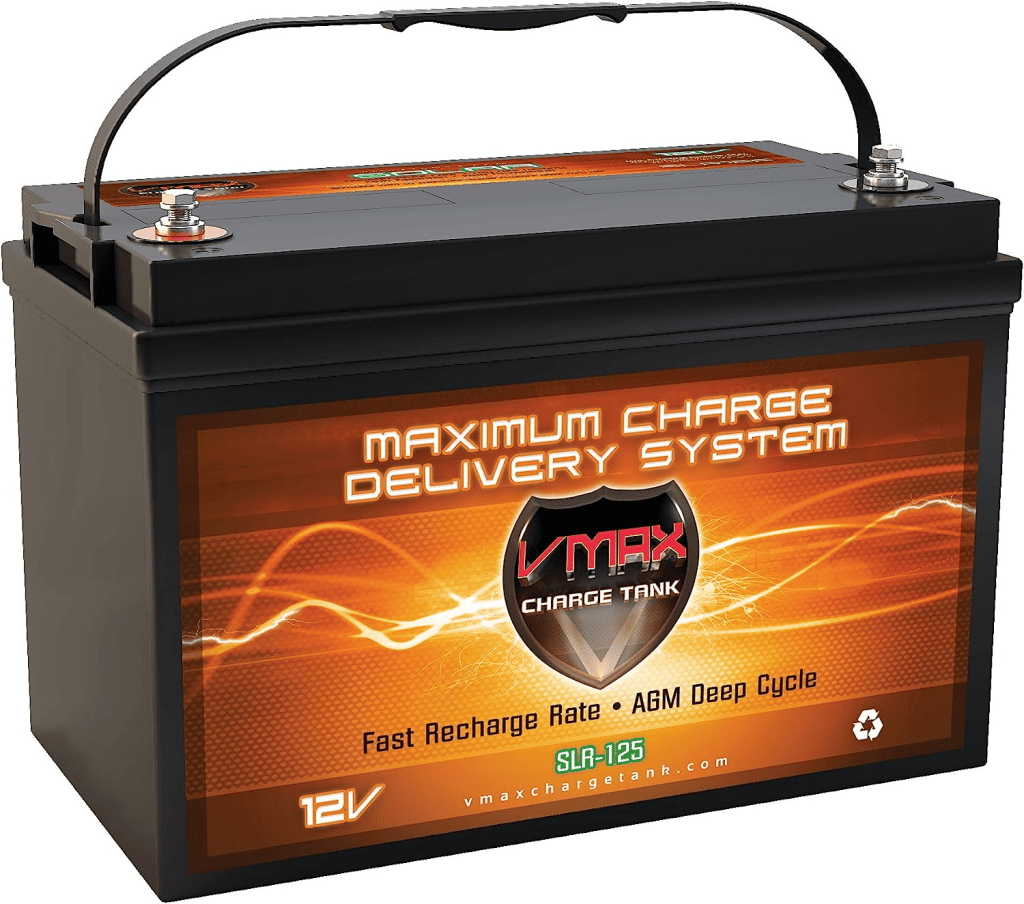
At a glance:
| Brand | VMAX |
| Model | VMAXSLR125 |
| Capacity | 125 Ah |
| Voltage | 12 Volts |
| Weight | 75 pounds |
| Dimensions (L x W x H) | 12.9 x 6.8 x 8.7 inches |
| Float Service Life Span | 8 to 10 years |
| Recommended Discharge | Up to 50% |
Why we love it:
If you’re on the hunt for a heavy-duty deep cycle battery with exceptional capacity, look no further than the Vmaxtanks VMAXSLR125 AGM battery. Boasting an impressive 125 Ah capacity, this battery is a perfect companion for extended camping trips and off-grid excursions in your RV. With two of these 125Ah batteries, you’ll have more than enough power to keep your RV running smoothly during your adventures.
One of the standout features of the VMAXSLR125 is its remarkable durability. The internal plates, designed to protect battery cycles, are reinforced to minimize self-discharge over time. This means you can rely on this battery for extended periods without worrying about rapid power loss. Moreover, this battery utilizes AGM (Absorbent Glass Mat) technology with military-grade plates, making it exceptionally sturdy and capable of handling harsh weather conditions like a champ.
Safety is paramount when it comes to batteries, and the VMAXSLR125 delivers on that front too. With 99% recombination capabilities, this battery ensures that dangerous gas and fume leakages are virtually non-existent, providing you with peace of mind during your RV adventures. Additionally, its vibration resistance further adds to its robustness, allowing you to mount the battery in any direction you desire, whether indoors or outdoors.
The VMAXSLR125 also features the Maximum charge delivery system, which offers a relatively fast recharge rate. As a deep cycle AGM battery, it is advisable to use a trickle charger to maintain the batteries over winter and only discharge them to 50% to prolong their lifespan and optimize their performance.
This battery is built to last, making it a worthwhile investment that will serve you well for years to come. However, it is worth noting that its exceptional capacity and robust construction come at a cost – the battery is quite heavy and larger compared to other deep cycle batteries.
Pros
- High capacity
- Exceptional durability
- Solar power compatibility
Cons
- Large and heavy
- Limited discharge depth of 50%
Factors to Consider When Choosing AGM RV Batteries
Selecting the right AGM RV battery for your needs requires careful consideration of various factors to ensure a seamless and enjoyable RVing experience. Here are some essential factors to keep in mind:
Capacity and Power Requirements
The capacity of an AGM battery is measured in ampere-hours (Ah), and it indicates the amount of charge the battery can hold. To determine the ideal capacity for your RV, consider the power requirements of all your appliances and electronics that will run on the battery.
Make a list of all devices you plan to power, including lights, fans, refrigerators, laptops, and other electronics, and calculate the total power consumption in ampere-hours for a typical day. It’s essential to have a buffer and choose a battery with a slightly higher capacity than your calculations to ensure sufficient power during extended off-grid stays.
Battery Size and Space Constraints
Check the dimensions of the battery and measure the available space in your RV’s battery compartment to ensure a proper fit. AGM batteries come in various sizes, so it’s essential to find one that fits snugly in the designated area without the need for modifications or extensive rearrangement of equipment.
Additionally, consider the weight of the battery, as it can impact your RV’s overall weight distribution.
Deep Cycle vs. Dual Purpose Batteries
AGM batteries are generally designed for deep cycling, which means they can handle being discharged to a low state of charge repeatedly without damage. Deep cycle batteries are ideal for RV applications since they are meant to provide steady and reliable power for extended periods.
However, some AGM batteries are dual-purpose, combining starting power and deep cycling capabilities. If your RV battery needs to serve as both a starter battery for your engine and a house battery for your appliances, a dual-purpose AGM battery may be a suitable option.
Charging Efficiency and Recharge Time
Consider the charging efficiency of the AGM battery to ensure you can quickly recharge it when needed. AGM batteries generally have good charging efficiency, but some models may charge faster than others.
Faster recharge times can significantly impact your off-grid experience by reducing downtime and allowing you to spend more time enjoying your travels. Keep in mind that the charging speed will also depend on the capacity of your RV’s charging system.
Durability and Vibration Resistance
As RVers, you’ll encounter rough terrains and bumpy roads, which can subject your battery to vibrations and shocks.
Choose an AGM battery with a sturdy construction and good vibration resistance to ensure it can withstand the rigors of travel. A battery with vibration resistance will have a longer service life and be less prone to internal damage caused by frequent movement.
Safety Features
Safety is of utmost importance when it comes to RV batteries. Look for AGM batteries with built-in safety features, such as overcharge protection and temperature control, to prevent damage to the battery and ensure safe operation. Some batteries also have built-in safety mechanisms that protect against short circuits and reverse polarity.
Price and Warranty
Consider your budget when selecting an AGM RV battery. Prices can vary based on the battery’s capacity, brand, and additional features. While higher capacity and advanced features may come at a higher cost, it’s essential to balance your budget with your power requirements.
Additionally, check the battery’s warranty to ensure you’re covered in case of any defects or malfunctions.
Proper Maintenance of AGM RV Batteries
AGM batteries are known for their low maintenance requirements, but some basic care practices can extend their lifespan and performance. Here are some essential maintenance tips for your AGM RV battery:
Regular Inspections and Cleaning
Periodically inspect your AGM battery for any signs of damage, corrosion, or leaks. Check the battery terminals for any buildup of dirt or corrosion, as this can affect the battery’s performance. Clean the terminals with a mixture of baking soda and water to remove any corrosive buildup. Remember to wear safety gloves and goggles during the cleaning process.
Correct Charging Techniques
AGM batteries perform best when they are charged properly. Use a high-quality AGM battery charger that is specifically designed for AGM batteries. Avoid using chargers meant for traditional lead-acid batteries, as they may not provide the right charging voltage and current for AGM batteries. Follow the manufacturer’s instructions for charging and avoid overcharging the battery, as this can lead to damage.
Storing AGM Batteries
If you store your RV for an extended period, it’s essential to take proper care of the AGM battery during storage. Fully charge the battery before storing it to prevent sulfation, which can occur if the battery is left in a discharged state for a long time. If possible, disconnect the battery from the RV to prevent any parasitic drains on the battery during storage.
Tips for Extending the Lifespan of AGM RV Batteries
AGM batteries are designed to provide reliable power for an extended period, but proper care and maintenance can further enhance their lifespan. Here are some tips to extend the lifespan of your AGM RV battery:
Avoid Over-Discharging
AGM batteries can handle deep cycling, but frequent deep discharges can shorten their lifespan. Try to avoid fully discharging the battery whenever possible. If you notice the battery voltage dropping below 50% or your RV appliances starting to show signs of reduced power, it’s time to recharge the battery.
Use Solar Power for Charging
Harness the power of the sun by using a solar panel system to charge your AGM RV battery. Solar charging is eco-friendly and allows you to recharge your battery during daylight hours, reducing the strain on your RV’s charging system. It’s an excellent option for extended off-grid stays and boondocking adventures.
Temperature Control
Keep your AGM battery in a cool and well-ventilated area to maintain its performance and extend its lifespan. High temperatures can lead to accelerated battery degradation, so avoid storing your battery in direct sunlight or in hot, enclosed spaces.
Regular Use and Recharging
AGM batteries benefit from regular use and charging. If your RV will be sitting idle for an extended period, make sure to recharge the battery every few weeks to prevent self-discharge and sulfation. Keeping the battery charged will ensure it remains in optimal condition and ready for your next adventure.
Avoid Overcharging
While proper charging is crucial for AGM batteries, it’s essential to avoid overcharging as well. Overcharging can lead to the battery overheating and cause irreversible damage. Invest in a high-quality AGM battery charger with built-in safety features to prevent overcharging.
Rotate Battery Use
If you have multiple AGM batteries, rotate their use regularly to ensure equal wear and tear. This practice prevents one battery from becoming significantly weaker than the others and extends the overall lifespan of your battery bank.
Regular Maintenance Checks
Perform regular maintenance checks on your AGM battery, including cleaning the terminals and inspecting for any signs of damage. Address any issues promptly to prevent further deterioration.
FAQs About AGM Batteries for RV
Are AGM batteries safer than lead-acid batteries?
Yes, AGM batteries are generally considered safer than traditional lead-acid batteries. The main safety advantage of AGM batteries lies in their design, which incorporates a unique glass mat separator to hold the electrolyte, rather than freely flowing liquid electrolyte found in flooded lead-acid batteries.
AGM batteries are sealed, which means there is minimal risk of acid spills or leaks, making them more environmentally friendly and safer for indoor use. Additionally, the sealed design prevents the emission of potentially harmful gases during charging, making them safer in confined spaces.
Furthermore, AGM batteries are less prone to sulfate buildup, a common issue that can lead to reduced battery performance and a shorter lifespan in traditional lead-acid batteries.
While no battery is entirely risk-free, AGM batteries’ construction and characteristics generally make them a safer and more user-friendly option compared to flooded lead-acid batteries.
Can I use a regular lead-acid battery charger for AGM batteries?
No, it is not recommended to use a regular lead-acid battery charger for AGM batteries. AGM batteries have different charging requirements than traditional lead-acid batteries. AGM batteries are more sensitive to overcharging, and using a regular lead-acid charger may not provide the precise charging profile that AGM batteries need.
To properly charge AGM batteries and extend their lifespan, it is best to use a charger specifically designed for AGM batteries. These chargers are equipped with algorithms that ensure a proper charging cycle, preventing overcharging and optimizing the battery’s performance. Using the correct charger will help maintain the health and efficiency of your AGM batteries and ensure they provide reliable power for your RV or other applications.
How long do AGM RV batteries last?
AGM RV batteries typically have a lifespan of 7 to 10 years, but this can vary based on factors such as usage patterns, maintenance, charging practices, and environmental conditions.
With proper care and regular charging, AGM batteries can provide reliable power for your RV adventures, but it’s essential to monitor their health and consider replacement when their performance starts to decline to avoid unexpected power failures during your travels.
Can I use solar panels to charge AGM batteries?
Absolutely! AGM batteries are compatible with solar panels and are an excellent choice for off-grid camping. Solar panels can charge AGM batteries efficiently, allowing you to enjoy a sustainable and eco-friendly power source.
Are AGM batteries suitable for cold-weather camping?
Yes, AGM batteries perform well in cold weather. However, extremely low temperatures may reduce their capacity temporarily. Keep in mind that all batteries, including AGM batteries, will experience reduced performance in very cold conditions.
How do I dispose of an old AGM battery?
AGM batteries are recyclable. To dispose of an old AGM battery responsibly, take it to a recycling center or return it to the retailer where you purchased the new battery. Avoid discarding AGM batteries in regular waste bins or landfills, as they contain hazardous materials that can harm the environment.
Conclusion
In conclusion, AGM batteries are a reliable and popular choice for RV power needs, providing maintenance-free operation, deep cycling capabilities, and spill-proof design. They are an ideal power solution for RVers seeking reliable electricity during their adventures. However, it’s essential to consider factors such as budget, power requirements, and weight when selecting the best AGM battery for RV.
We hope this guide has helped you understand the features and benefits of AGM batteries, allowing you to make an informed decision for your RV’s power needs. Now, you can embark on your next RV journey with the confidence of a dependable AGM battery by your side. Happy travels!

